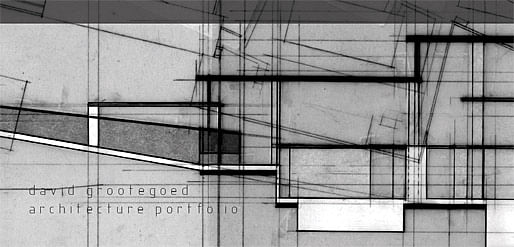

by James Long/Ellicott Long
Continuing our Graduate Theme, we now focus on Part 2 of our article for Architecture and Design Graduates.

Assembling a Portfolio
In this section I will focus on putting together a portfolio. As a graduate, this is likely to be made up of around 90% university/education work and 10% practical experience. I think it’s important to keep the practical and academic experience separated with the focus being on the work that YOU have undertaken as a designer. As your career develops, the percentage of the portfolio that is academic based should decrease as the practical/professional experience takes precedence.
Your university portfolio is in essence what shows a potential employer how you approach a design problem and the design solution you come up with. Therefore it should be fairly detailed including work from earliest design briefs and sketches through to more detailed drawings and any models constructed. It should tell the story of a project and be easy to follow and most importantly show the employer your strengths and what you could bring to their company. A lot of design portfolios simply include pretty 3D renderings of the final design. These are important but only show a small part of the process you have completed. If you have spent a year working on a design project, show a year’s worth of work. Compile the portfolio in reverse chronological order starting with your most recent work first and working backwards. Include some written descriptions if necessary but remember this is a visual tool. Also make sure you include any drawings you have done with specialist software to reaffirm the information on your CV (e.g. Rhino, Maya, 3D Max, Environmental Modelling Software)
A lot of people ask me here how big their portfolio should be in terms of amount of content. I am of the opinion that you should almost take along too much work and then from your research prior to interview (and feeling at interview) decide which parts of the portfolio you will spend most time on – if you take a large portfolio, remember you don’t need to go through all of it, allow the interviewer to feedback and guide you if you are unsure. I will go into more detail on presenting the portfolio during the Interviewing Successfully part of this article to follow next week.
I am also asked how big physically the portfolio should be. I would say that 90% of the portfolios I see are A3 size. This is usually the easiest size to transport to and from interviews and is usually enough to present a high enough level of detail. The best portfolios are those that are presented in a binder/folder and can be flicked through like a book during interview. Take the time to organise the portfolio in a folder or bind it – there is nothing worse than someone scrabbling through loose sheets of paper trying to find a drawing. And then you have to reorganise it for every interview.
This leads on to whether you should show a hard copy (paper) portfolio or an electronic (PDF/Power Point/etc) portfolio. I think that most companies still prefer to see hard copy printed portfolios. However, in the age of more specialist software tools and 3D renderings it can be useful to have an electronic copy as well. If you do take along an electronic portfolio I’d recommend taking your own laptop – an employer may not have the ability to read a CD or USB memory stick in the interview room. Make sure the laptop is fully charged and if necessary turned on when the interview starts. Organise the portfolio efficiently ideally into one presentation file as a PDF or equivalent. There is nothing more frustrating than trying to locate an image in the midst of hundreds of folders – it’s akin to sifting through a pile of loose papers as outlined above. It’s ok to have some separate files to show, just make sure you can access them easily and quickly. For example you may have created a video fly-through to show alongside your image portfolio.
Any work you have done at a design company should also be included in your presentation. After all, this shows a client what you have actually done in a work environment previously. Don’t worry if you don’t have lots to show here, you are not necessarily expected to. However, do make sure that if you have spent 6 months working for someone, you show that work. Any practical design drawings should again tell a story where possible. Don’t just put in pretty 3D renderings of projects or completed photos, include working drawings, technical designs, sketches, details and anything you think relevant. Yes, even include those toilet details. The more you can present, the more the client can see the value you can add to their company.
Finally, once you have completed a portfolio ready to present at an interview, I highly recommend creating a condensed, email-able selection of work samples to send with an initial application. This does not have to be as extensive as the full portfolio but should give a flavour of your design experiences. I think that 10-20 PDF pages/slides is more than sufficient and generally speaking try to keep this file size below 5MB so it can pass through most email systems.

Applying for Positions
Now your CV, cover letter and portfolio are almost ready, it’s time to start applying for positions. The important thing here is to take time to prepare before sending anything out. Make sure you speak to your fellow graduates, tutors or anyone you know in the industry to understand where your skills may fit best and start to decide the type of company you wish to work for. Most graduates I have met are fairly open to options which is fine, but it is still worth generating a list of companies and putting together a plan of how to approach each of them. The key thing about applying for positions is to make the recipient of your application feel like you have specifically targeted them and the company personally over all others. Too many graduates (and candidates in general) send out a load of generic applications hoping that quantity will win out over quality. The truth is there are usually many more graduates looking for work than there are available positions so you have to make your application stand out over all the generic ones. At this stage it is about getting your foot in the door with a company and giving yourself the opportunity to meet someone face-to-face.
Once you have decided on the companies you wish to apply to it’s time to research. You should systematically go through each company and try to find the correct point of contact to get your details across to. This will usually involve going to company websites but information tends to be limited on these (usually to keep us recruiters away!). The most effective way to get information is to call the company and ask for the correct point of contact and their email address. This can be quite daunting but is well worth the effort. And yes, there are some very good gatekeepers out there who will tell you to send your CV to a generic HR inbox – don’t worry, be persistent (not pushy!) and keep researching. If you want to work for a company enough you should be able to reach someone who can point you in the right direction.
Tip: If you can find out just one person’s email address in the company and know the name of the contact you should be applying to, you can sometimes figure out your contacts email address. For example, if you know someone called Joe Blogg’s working at a firm and know their email is jbloggs@design.com, you can quickly see that your contact John Doe’s email is likely to be jdoe@design.com.
The reason for targeting your approach to someone specific is simple: A lot of companies HR inboxes can be like black holes receiving scores of applications daily which are sometimes simply overlooked. The more direct your approach is, the better you can navigate the HR black hole and again, get your foot in the door. In essence, take a proactive approach.
The reason I have said things are almost ready above is because this is where you need to start personalising things. Once you have a contact, you should personalise the cover letter and ensure the CV and letter are tailored to the company you are applying to. If you are responding to an advert make sure to include any reference numbers and follow instructions on the advert. If it asks you to quote something in the email subject, quote it. If it asks you to submit an application in writing and by post only, post it. If it says to include work samples no bigger than 3MB, don’t send your 5MB attachment. Not following instructions is the easiest way to receive a rejection email or to not be considered.
Next, apply for the role. If by email, simply write a couple of lines stating you would like to apply for an advertised position (quote reference numbers) or enquire about any available positions. DO NOT just copy your cover letter into your email. It is sometimes ok to substitute your cover letter into a cover email but I think it is best to attach a separate cover letter. Your email should be short and to the point and of course addressed to the recipient. If applying by post, send in an A4 envelope with a signed cover letter and a print out of your work samples.
It’s not quite over yet though. If you are applying to a lot of companies, it will be easy to lose track of what you have done. Therefore I strongly recommend you keep a record of each application you have made and when you made it. Being organised here allows you to complete the final step of the application procedure, the follow up. If you have applied to a company and have not heard anything after a period of time (usually 5-7 days) it can be extremely beneficial to follow up your application. This can be by email but ideally should be by calling the person you applied to. A simple “I wanted to see if you have had the chance to review my application and have any feedback” will suffice and will highlight you as someone who is proactive and enthusiastic. It also allows you to keep track of where your applications are. Remember though, be polite and don’t be pushy. This should just be a quick follow up to put your application on their radar.
What I have outlined so far may sound like a long and complicated process but taking the time now to do things right will give you the best possible chance to secure an interview. I would say that out of every 10 people that apply for a position, only 1 or 2 will make the necessary effort I’ve described. I’ll leave it to you to figure out which of the 10 people will be asked to attend interview!
Move on to Part 3.
No Comments
Block this user
Are you sure you want to block this user and hide all related comments throughout the site?
Archinect
This is your first comment on Archinect. Your comment will be visible once approved.